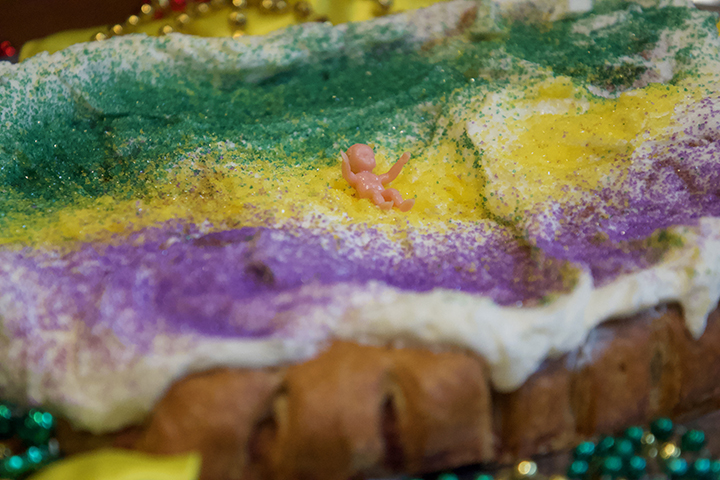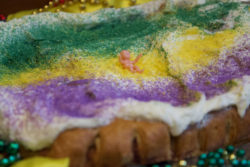Foodways
Long Live the King
King cakes usher in Carnival season
Published: January 6, 2016
Last Updated: January 4, 2021

In New Orleans, king cake is a Carnival tradition.
King cakes are traditional in many areas of the world and get their name from the three Biblical kings who journeyed to honor the Christ child with gifts of gold, frankincense, and myrrh on the twelfth day after his birth. The day is known to Christians as Epiphany and is celebrated on January 6. In areas where Roman Catholicism holds sway, the kings’ visit is celebrated in many ways. In Hispanic countries, children receive their gifts not from Santa Claus, but from the kings, also sometimes known as the Three Wise Men. In Mexico, the occasion is celebrated with a cake called la rosca de reyes. In France, the Kings are celebrated with a flaky confection known as the galette des rois. This cake is usually layers of puff pastry filled with a thick frangipane mixture. Inside hides a small figurine called a fève in remembrance of the small fava bean that was historically placed in the cake. The individual who is given the slice of the cake containing the fève becomes the ruler for the day. Modern French bakeries offer these cakes throughout the month of January, usually surrounded by a gilt paper crown all ready for the ruler’s coronation.
In New Orleans, where both Hispanic and French traditions converged, the arrival of the king cake on Epiphany also signals that it is the time of year to think of the reign of another king: Rex —the King of Carnival. Around the world, kings are traditional icons of the pre-Lenten Carnival season, from those who reign from atop floats to those who parade through the streets greeting their public on a more humble scale. The celebration of carnival predates Christianity and is thought to hark back to Roman days of Saturnalia, a holiday marking the dedication of a temple to Saturn, the god of agriculture. It was a festive time when the everyday world was turned topsy-turvy. Schools were closed, gambling was allowed in public, and slaves could not be punished. Indeed, some have said that on that occasion a slave king was elected and subsequently executed at the festival’s end. Many of the traditions surrounding Saturnalia became part of the celebration of Carnival including that of electing a commoner king.
In the New World where Africans were enslaved, the tradition of blacks becoming kings and queens for a day became an integral part of the pre-Lenten festivities. In Recife, in northeastern Brazil, carnival kings and queens of the Maracatú parade through the streets in elaborate costumes usually carrying a baby doll representing their heir, known as the Calunga. In 19th-century Cuba, during Carnival, the cabildos (fraternal groups that were often formed around the various African nations from which the slaves came) also elected royalty. Early images show the Cuban parades of the kings and queens of Congo who ruled over their betters for the Carnival season. In present day Salvador da Bahia, Brazil, Carnival season is ushered in by the election of el Rei Momo, the fattest and supposedly jolliest man in town who supplants the mayor and rules over the city during the days of Carnival.
The celebration of Carnival predates Christianity and is thought to hark back to Roman days of Saturnalia.
In Louisiana, where the “Kingfish” Huey P. Long declared “every man a king,” the words are true, at least for the season that celebrates what writer and social chronicler Robert Tallant called the “revival of monarchic rule.” Organizations known as krewes, from Bacchus to Zulu, elect their kings and select their queens. In times past however, the election of carnival kings and queens was a more intimate affair. According to the Picayune Cookbook:
The method of first choosing the king was by cutting the King’s Cake….When Twelfth Night arrived there was always a flutter in old Creole New Orleans. Generally some grand mansion was chosen for the first ball, and as the evening progressed, when the clock struck twelve, the guests were all invited to be seated around the spacious dining room where the “King’s Cake” was brought in. Now, hidden away somewhere in the cake was a bean, or often as not a magnificent jeweled ring. The cake was cut into as many slices as there were guests, the smiling cavaliers and the lovely Creole maidens ranged around,…
If a man found the fève, he became the king and selected his queen. If the lucky individual was a woman, she was named queen and selected her king by offering him a bouquet of violets which always was provided with the cake. No matter how the king was chosen, he was expected to “bear the entire expense of the ball of which he was king, and to provide the King’s Cake” for the next ball. At the following ball that cake was cut, a new king and queen chosen, and so it continued with weekly balls until the final ball of Mardi Gras evening.
Today, for the general public, things are considerably less lofty. King cakes are more commonly found at office parties and school gatherings and the “king” or ”queen” is only responsible for providing the cake for the next gathering. The cake has changed as well. The French cake of puff pastry layered with frangipane was initially transformed in Louisiana into a brioche-type twisted bread decorated with candies, caramels, and the sprinkles and Jordan Almonds, known as dragées in French. Today, many have morphed into what one writer has called a “sticky coffee-cake type confection” topped with purple, green and yellow (or gold) sprinkles, or glazes in the trilogy of carnival colors.
The féve or fava bean that is found by the king or queen has changed as well. Today, the bean is more often than not a small plastic baby in one of the carnival colors of purple, green, or gold. But there are new trends. French traiteurs like Fauchon and Hédiard put out their own highly collectible annual series of king cake babies as does Haydel’s Bakery in New Orleans. Haydel’s offers a different New Orleans’ icon each season and has included king cake babies like Mardi Gras Indians, the Rex float, and an especially memorable post-Hurricane Katrina FEMA trailer.
Several years ago, another friend of mine, Gail McDonough, started me on a collection of Haydel’s king cake babies. So every year right after Christmas and Kwanzaa at the beginning of the carnival season, I now emulate Lenora polishing up my mirror, getting ready to show off my collection, and starting off the Carnival season by advertising my allegiance to the Crescent City. I may never be the empress I was truly born to be, but in New Orleans, if I snag the right piece of king cake, at least I have as much chance as anyone to become queen for a day.
———
Jessica B. Harris, Ph.D., is the author of eight books documenting the foods and foodways of the African diaspora.
